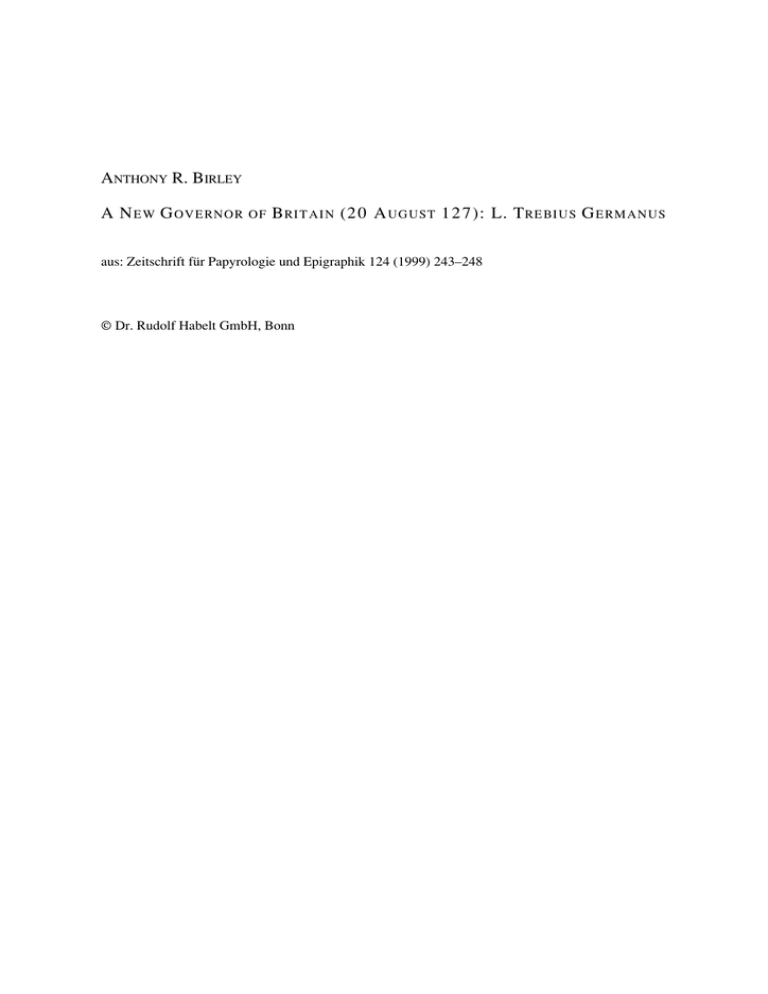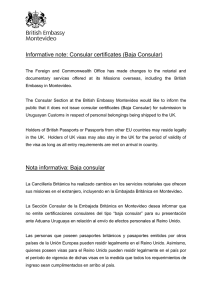aus: Zeitschrift für Papyrologie und Epigraphik 124 (1999) 243–248
Anuncio

ANTHONY R. BIRLEY A N E W G OVE RNOR OF B RI T AI N (2 0 A UGUST 1 2 7 ): L. T RE BI US G E RM ANUS aus: Zeitschrift für Papyrologie und Epigraphik 124 (1999) 243–248 © Dr. Rudolf Habelt GmbH, Bonn 243 A N E W G OVE RNOR OF B RI T AI N (2 0 A UGUST 1 2 7 ): L. T RE BI US G E RM ANUS A new diploma has recently come to light (provenance unknown, probably the Balkans), dated 20 August 127 and registering eight alae and twenty-seven cohorts in Britt(ania) sub Trebio Germano.1 This governor can be identified as the suffect consul L. Trebius Germanus, colleague of C. Calpurnius Flaccus,2 the year being calculated as ‘c. 124’ from Flaccus’ career.3 This date can perhaps be slightly refined. Trebius Germanus is also known from the Digest, which cites a judgment he delivered when governor of an unspecified province, not necessarily Britain. He sentenced a slave-boy to death: ‘Slaves below the age of puberty are exempted under the Senatusconsultum Silanianum [perhaps of AD 10]. To be sure, the legate Trebius Germanus ordered the penalty to be carried out even on an immature slave, but not without reason. For that boy was not far off the age of puberty and had been lying at the feet of his master when the latter was killed, and he did not subsequently reveal the murder. While it was agreed that he was not able to bring help, it was equally certain that he had maintained silence. He (Germanus) believed that slaves, providing that they are below the age of puberty, are spared under the decree of the senate if they had simply been under the same roof. But those who were accomplices or participators in the murder and were of an age, even if not adult, to understand the matter, ought not to be spared in the case of a master’s murder any more than in another case.’ 4 The same chapter of the Digest cites part of a rescript of Hadrian – perhaps occasioned by Germanus’ decision? – on the interpretation of this Senatus Consultum.5 As the editor of the new diploma refrains from speculation about the governor’s background and career, and is unwilling to detect him on any British inscriptions, some brief reflections, necessarily tentative, may be offered here. Trebius Germanus was not the only bearer of this gentilicium to be consul under Hadrian: C. Trebius Maximus was cos. suff. in 121 or 122, C. Trebius Sergianus cos. ord. in 132. Yet, as Ronald Syme put it, ‘the obscure Trebii . . . are the first and last consuls of that name’; elsewhere he called them ‘a unique and isolated group’.6 Be this as it may, all three governed at least 1 J. Nollé, ‘Militärdiplom für einen in Britannien entlassenen ‘Daker’, ZPE 117, 1997, 269–276, pp. 274–6 being an ‘Addendum’ by M. M. Roxan, revising the list of units on the basis of a further fragment. On the provenance, cf. p. 270 n. 2. The recipient, a ‘Dacus’ not necessarily from north of the Danube, was presumably recruited in AD 102, at the end of the 1st Dacian War, and had served in coh. II Lingonum equit. Cf. further below for comment on the garrison and comparison with that now attested on the same day in Lower Germany (n. 29). 2 ILS 7912 = CIL VI 10241: act. XVIII k. Ianuar. C. Calpurnio Flacco L. Trebio Germano cos. 3 A. R: Birley, Fasti of Roman Britain, 1981, 237, on Flaccus as a possible legate of II Augusta, with n. 6, cited by Nollé (n. 1 above) 271 n. 12. 4 Digest 29.5.14: MAECIANUS libro undecimo de publicis iudiciis. Excipiuntur senatus consulto Silaniano impuberes servi. Trebius autem Germanus legatus etiam de impubere sumi iussit supplicium et tamen non sine ratione: nam is puer nec multum a puberi aetate aberat et ad pedes domini cubuerat cum occideretur nec postea caedem eius prodiderat. ut enim opem ferre non potuisse constabat, ita silentium praestitisse etiam postea certum erat, et his dumtaxat impuberibus senatus consulto parci credebat, qui tantum sub eodem tecto fuissent: qui vero ministri vel participes caedis fuissent et eius aetatis, quamquam nondum puberis, ut rei intellectum capere possent, his non magis in caede domini quam in ulla alia causa parci oportere. 5 Ib. 29.5.1.28. Hadrian is there quoted, in particular, for a ruling on a slave-girl, who claimed that she had not cried out for help while her mistress was being murdered because the murderer had threatened to kill her if she did. Hadrian’s view was that slaves should not put their own safety before that of their owners: the girl deserved the death penalty. Trebius Germanus’ decision was similar. 6 R. Syme, Roman Papers IV, 1988, 309: ‘And after a time follows a run of consuls with no discoverable ancestry, among them Antonius Rufinus (131), Trebius Sergianus (132), Mummius Sisenna (133) . . . The obscure Trebii, who show suffecti in 121 and 125, are the first and last consuls of that name.’ Cf. id., ib. v (1988) 557: ‘The next year [AD 132] was opened by C. Junius Serius Augurinus and C. Trebius Sergianus. Each only a name. Two other Trebii arose, viz. Maximus 244 A. R. Birley one imperial province: Maximus was praetorian legate of Lycia-Pamphylia in the last years of Trajan, 115–117, Germanus consular of Britain in 127, Sergianus praetorian of Galatia in 128. Maximus’ consulship, in November and December of a year to be determined, had clearly been deferred. He might have expected it in 118, but the change of emperor no doubt gave priority to favourites of Hadrian and to men who had earned distinction in the Parthian War. Maximus’ consular colleague, T. Calestrius Tiro Orbius Speratus, who had governed Cilicia at about the time that Maximus held Lycia-Pamphylia, also suffered retardation. By contrast, Maximus’ successor in Lycia, T. Pomponius Antistianus, was consul before him, in summer 121.7 The pair Maximus and Tiro is customarily assigned to the last two months of 122 on the basis of a diploma, on which the first editor, R. Thouvenot, read Hadrian’s tribunician power as VI. But H. Nesselhauf favoured 121: the trib. pot. number in the photograph looked to him like V. Syme, who cited Nesselhauf, also found 121 more plausible in view of the consulship of Pomponius Antistianus. Thouvenot’s reading is defended in the republication of the diploma. But the photograph there does not make VI any more convincing.8 Where did these Trebii come from? The question is at least legitimate, even if there is no ready answer. The proportion of governors of provincial origin seems to increase from Hadrian onwards. One need list only, for Britain between 122 and 142, Q. Pompeius Falco, from Sicily (?); A. Platorius Nepos, probably from Spain (still uncertain); Sex. Julius Severus, from the colony Aequum in Dalmatia; P. Mummius Sisenna, from Osset in Baetica; Q. Lollius Urbicus, from Castellum Tidditanorum in Numidia.9 The gentilicium Trebius, which is Oscan, and is also found as a praenomen, is fairly widely distributed, without being particularly common. 10 As it happens, a Trebius is named by a contemporary author: in his fifth Satire, Juvenal uses the name for a humiliated client. The poet even wonders whether this Trebius may rise in the world and become a dominus and a rex domini himself – the poet advises him, if he aspires to this, not to have children. Trebii are attested precisely at Aquinum, supposedly the poet’s home, which has encouraged speculation.11 In fact, Juvenal’s own origin there is far from certain: he might have been provincial.12 It would be tempting at this period to look for kinsmen of Trebius Germanus in the provinces. Spain shows ten Trebii, and, what is more, a C. Platorius Trebianus at Gades.13 It would be pleasant to suppose that Trebius Germanus was connected to Platorius Nepos and (suff. ?121) and Germanus (?125), forming a unique and isolated group’, with a footnote comment: ‘No consul before or since.’ 7 Details under the appropriate provinces and years in: W. Eck, Jahreslisten der senatorischen Statthalter von 69/70 bis 138/139, 1., Chiron 12, 1983, 281–362; 2., ib. 13, 1983, 148–237; and B. E. Thomasson, Laterculi Praesidum I, 1984. 8 CIL XVI 169 (cf. Nesselhauf ad loc.), republished as IAM II 239; Syme, Roman Papers II, 1979, 779 and n. 2 (first published in 1969). 9 There is new evidence for Falco: W. Eck, Senatorische Familien der Kaiserzeit in der Provinz Sizilien, ZPE 113, 1996, 109–128, with results already available to O. Salomies, Adoptive and Polyonymous Nomenclature in the Roman Empire, 1992, 121 f. Nepos: Fasti of Roman Britain (n. 3) 101. Severus: ib. 107 f.; cf. further, on his adoption by Cn. Minicius Faustinus, Salomies 126 ff. Sisenna: AE 1983. 518 confirms and specifies the Spanish origin conjectured in Fasti 110; cf. also K. Dietz, Die Mummii Sisennae und der Wiederaufbau der Basilike Stoa von Thera, Chiron 23, 1993, 295–311, showing that this Sisenna was not, as previously assumed, proconsul of Asia under Pius. Urbicus: Fasti 113. After Urbicus it is difficult to find a single governor, apart from P. Helvius Pertinax (180s), probably Pollienus Auspex (Severan), and Desticius Juba (mid-3rd century, Britannia superior), who was demonstrably Italian: Fasti 142 ff., 155, 178. 10 W. Schulze, Zur Geschichte lateinischer Eigennamen, 2nd ed. 1933, 246, 375, 468 f., 480; O. Salomies, Die römischen Vornamen, 1987, 94, 158, 160. 11 P. Green, Juvenal. The Sixteen Satires, Penguin Classics 1967, 124: ‘A Trebius Sergianus was consul in AD 132 . . . it is pleasant to think that this might conceivably be the same man, and that Fortune, after his early humiliations, smiled on him in his later years. The name also occurs several times in inscriptions from J.’s birthplace, Aquinum’, viz. CIL X 5528–9: P. Trebius P. f. R[. . .] and P. Trebius P. l. D[. . .]. The other two consular Trebii, only suffect consuls, are not mentioned by Green. 12 R. Syme, Roman Papers III, 1984, 1120 ff. 13 CIL II 1861. A New Governor of Britain 245 that he derived – as Nepos may have done – from the home province of Trajan and Hadrian. But the Spanish evidence offers much too fragile a basis. None of the Spanish Trebii, nor this Trebianus, are persons of rank. As for southern Gaul, it so happens that F. Münzer once conjectured that the earliest recorded Trebius of the better sort, an equestrian officer in the proconsul Caesar’s army, M. Trebius Gallus, might have been from an Italian trading family long resident in Narbonensis, specifically at Tolosa.14 The cognomen of this man, one might add, is of the same type as ‘Germanus’ – but, unlike ‘Gallus’, ‘Germanus’ is not known to have been borne by any Roman senator, apart from our Trebius.15 (The most obvious explanation for that name in this one case would be that our Trebius was born in Germany.) At first sight Dalmatia or Liburnia looks more hopeful. M. Trebius Proculus, of equestrian rank and a magistrate in his home city, the Augustan municipium Arba, had a daughter married to a primipilaris, Q. Raecius Q. f. Cl. Rufus, decorated in both the Jewish War of AD 66–70 and in Trajan’s Dacian War.16 (The same M. Trebius Proculus was, it seems, one of three decurions who scr(ibendo) adf(uerunt) for a decree of the Aqueileia senate in the first half of the second century AD.)17 A grandson was a senator and consul under M. Aurelius.18 But this is probably a false trail. These people had not risen high enough in the age of Trajan and Hadrian. Note that a L. Trebius Proculus, perhaps from the same family, was an equestrian official in Egypt, epistrategus Heptanomiae, in AD 151.19 The most promising lead comes from Bononia (Bologna) in Italy. An inscription near there has the following text: C. Trebius C. f. Lem. Maxim[us] praef. fabr. q. IIIvir. aug. IIvir. pon[t.] C. Trebius Maximus Se[ ].20 (Might one not restore at the end of this text Se[rgianus] ?) Trebii are few in number in CIL xi, but there are another two at Bononia: C. Trebius L. f. Longus veteranus cohortis secundae praetoriae and T. Visulanius Aufidius Trebius Clemens, whose son T. Visulanius Crescens was praef. fabr. bis and went through the tres militiae, his first post being datable to AD 99.21 This looks just the right sort of milieu to locate the consular Trebii of Hadrian’s reign. One might postulate (but only as a hypothesis) that the early veteran of the Guard, C. Trebius L. f. Longus, was the ancestor, and that C. Trebius Maximus the local magnate who had also been praefectus fabrum was perhaps the grandfather of the two suffect consuls from the 120s – who might have been cousins. Germanus’ praenomen, Lucius, is found in the filiation of the guardsman. The polyonymous Visulanius whose nomenclature included Trebius presumably had a Trebia as mother or grandmother. The cos. ord. 132, Sergianus, may plausibly be supposed the son of the suff. c. 121, Maximus, whose praenomen Gaius he shares; Maximus may well have reached the consulship late in life. As for the name Sergianus, there are at any rate twenty Sergii in CIL xi.22 Perhaps the patronage of the three Ceionii Commodi, consules ordinarii in 14 RE 6A.2, 1937, 2271, Trebius no. 2, discussing BG 3.10.2 and 7.3, and citing CIL I.2 779 = XII 5388, from 47 BC, a slave-owner called L. Trebius. Another Trebius is also on record at Tolosa, with a cognomen of a similar kind: M. Trebius Creticus, on a bronze seal, CIL XII 5690121. 15 H. Solin, in W. Eck (ed.), Prosopographie und Sozialgeschichte, 1993, 22 f.: ‘Über die Verbindungen von L. Trebius Germanus, dem einzigen senatorischen Träger dieses Cognomens, mit Germanien wissen wir nichts.’ 16 CIL III 2917 = ILS 2647, Iader. 17CIL V 961, cf. p. 1025. Another signatory was L. Cammius Maximus, an equestrian officer from Flavia Solva, H. Devijver, Prosopographia Militarum Equestrium I, 1976, C 68; his brother L. Cammius Secundinus was procurator of Noricum under Antoninus Pius: G. Alföldy, Noricum, 1974, 274. 18 CIL III 3116 = ILS 3869, Arba (AD 173). 19 P. Mey. 8. His origin is of course unknown. Also attested in Dalmatia, under Caligula, is the praefectus castrorum, L. Trebius Secundus, praef. castr. CIL III 8472 = ILS 5948, Dalmatia, south of Salonae. But this man probably came from Italy, cf. ILS 5761 = CIL IX 3018, Teate Marrucinorum, from the right period. 20 AE 1976, 207. The tribe of this Trebius Maximus, ‘Lemonia’, included Bononia and only five other places in Italy (and nowhere outside the peninsula): J. W. Kubitschek, Imperium romanum tributim discriptum, 1889, 271. 21 CIL XI 708–9; for Visulanius Crescens, Devijver (n. 17) II, 1977, V 120. 22 For a short gap between consulships of father and son cf. the Mummii Sisennae, AD 133 and 146: Fasti (n. 3) 110, 246 A. R. Birley 78, 106 and 136 – the third of these being adopted by Hadrian in 136 as L. Aelius Caesar – helped the Trebii to enter the senate and rise to the consulship. The Ceionii were evidently from Bononia, not a city which produced many senators.23 Origin at Bononia for Trebius Germanus remains entirely conjectural, it must be reiterated. Further evidence may one day confirm or overthrow the suggestion. Meanwhile one may note that the equestrian officer named in the new diploma, prefect of coh. II Lingonum equitata, was a man previously known, C. Hedius Verus. The diploma supplies his origo unambiguously: Pitinum Mergens, in Umbria. This is an interesting minor correction: previous evidence had led to the inference that Hedius Verus’ home town was Forum Sempronii, not far away.24 The Trebii appear to fade out, in spite of the three Hadrianic consulars. At least, there is no trace of them after 132. It is, however, worth registering the existence a couple of generations later of two equestrian Trebii, Maximus and Germanus precisely: the former tribune of cohors II Ulpia equitata in 194,25 the latter tribune of the equites singulares Augusti in 197. 26 The Severan Trebii might even illustrate the hypothesis (for which there is little specific evidence) that ‘although some senators’ sons became senators, many more did not . . . many sons of consuls and of other senators simply opted out of politics.’27 But it is surely more likely that these two were, rather than grandsons, descendants of clients or freedmen of the consular Trebii (perhaps the latter had followed Juvenal’s advice to the poor client Trebius, Sat. 5. 138ff.: not to have children if he rose in the world). To return to the new governor of Britain: as already indicated, the consular year of Trebius Germanus may be calculated from the career of his colleague Calpurnius Flaccus, proconsul of Cyprus in 123, the term of office being more probably 122/123 than 123/124. In fact, if Trebius Maximus and Calestrius Tiro could be moved back from the last nundinum of 122 to that of 121, as suggested above, the corresponding period in 122 would become vacant for Flaccus and his colleague.28 Germanus, attested in Britain in August 127, might by then have been there for two years already. 29 Platorius Nepos, who became governor in summer 122, is attested on 15 September 124, so probably went on into 125, which would give him a three year tenure.30 All the same, it is just as possible that 249. This is the place to withdraw the suggestion made in ‘Hadrian and Greek senators’, ZPE 116, 1997, 209–245, at 226 n. 118, that the consular Trebii were from Antioch-towards-Pisidia in Galatia. It was based only on the name Sergianus, Sergii of senatorial rank at this time being not known from anywhere else than ‘Pisidian Antioch’. 23 R. Syme, Roman Papers VII, 1991, 633. 24 CIL XI 6123, cf. p. 1387, Forum Sempronii: he was patron of that municipium, a dozen miles distant from Pitinum. This inscription gives his full career, local as well as in the tres militiae, of which the prefecture under Trebius Germanus was his first post. He went on be be tribune in II Traiana (Egypt) and commander of the ala Indiana (Germania superior). Discussed at length by Nollé (n. 1) 272 f. 25 AE 1934.280; Devijver (n. 17), II, 1977, T 37. There are a few other Trebii among Devijver’s equestrian officers. 26 ILS 2185 = CIL VI 224. 27 G. P. Burton and K. Hopkins, in Hopkins, Death and Renewal, 1983, 194. To be sure, service as equestrian officer – not to mention as commander of the Imperial Horse Guards – is not exactly in line with these authors’ model of a senator’s son or descendant renouncing senatorial status in favour of ‘the luxurious life of a grandee’ (p. 192). 28 BCH 86, 1962, 404 = SEG XXIII 609, discussed by Eck 2 (n. 7) 157 n. 369. Flaccus had already been legate of Lu[sitania] or perhaps Lu[gdunensis], IGR iii 991, Salamis, set up by the council and people of that city; the offices of consul and proconsul are there restored. Flaccus and his colleague Trebius Germanus may at any rate be assumed to have held the fasces at latest in 123, rather than ‘ca. 124’ as suggested in Fasti (n. 3) 237. 29 His name would nicely fit the space on the Walcot diploma, CIL XVI 88 = RIB II.1, 2401.7: an upright followed by a maximum of 11 to 12 further letters. This diploma was issued on 15 September of a year which it was thought could be c. 126, M. M. Roxan, RIB II.1, p. 19 n. 7. But see now W. Eck and E. Paunov, Ein neues Militärdiplom für die Auxiliartruppen von Germania inferior aus dem Jahr 127, Chiron 27, 1997, 335–354, at 339, showing that it could after all, as previously supposed, be early Hadrianic. If so, the Walcot governor could just be e.g. Falco or Nepos: thus (citing Roxan, RMD I, p. 24) Fasti (n. 3) 94 f. 30 Fasti (n. 3) 100 ff., noting that the next certainly attested governor was Sex. Julius Severus (cos. 127), who governed Lower Moesia before going to Britain, ‘which he can hardly have reached before 130’, ib. 106 ff. A New Governor of Britain 247 Nepos stayed for more than the triennium sometimes thought to be standard,31 and continued in Britain into 126 or even 127. About Germanus’ previous career one can only state the possibilities. The likelihood is that he had governed a praetorian province, unless he had been, for example, a Treasury Prefect instead, probably under Hadrian, although of course he might have suffered delay, like his assumed kinsman Maximus. There are vacancies in the following praetorian provinces: Thrace, between Platorius Nepos (118) and Tineius Rufus (123); Aquitania; Arabia between Gargilius Antiquus (118/9) and Julius Alexander (124); Belgica; and either Lugdunensis or Lusitania, depending on which of the two was held by Calpurnius Flaccus. It is, further, at least plausible to suppose that Germanus had already governed another consular province before going to Britain, though it does make a tight squeeze, consul at earliest late 122, more likely late 123, consular governor of unknown province, 123 or 124 to 127, then Britain from mid-127. Several possible first provinces can be eliminated, not least Germania inferior (which several governors of Britain had held as first consular province): Platorius Nepos’ unknown successor there must have taken over before Germanus became consul. Cappadocia and Moesia inferior and probably Pannonia superior were occupied by others in the years between 122/3 and 127; and one will hardly suppose that Germanus had been in Syria or Hispania citerior before Britain. That leaves as possible first consular province Germania superior, Judaea and Moesia superior.32 There is at yet no certain record of Germanus in Britain. But the traces of a governor’s name in Horsley’s reading of a Hadrianic inscription from Bewcastle, now lost, might be reconciled with [L]Tr[ebio Germ]an[o].33 Further, on a fragmentary stone at the fort of Tomen-y-Mur in Wales, the bottom of two letters survive from a consular legate’s name. 34 One could now theoretically restore [L Tre]bi[o Germano leg Aug] pro [pr].35 A final item for discussion is the comparison between the British diploma and that for Lower Germany, issued on the very same day, 20 August AD 127. This also reveals a new governor, L. Coelius Rufus. One surprise is that this man, cos. 119, had previously governed a consular province, Moesia superior, where he is attested in 120. The editors can only produce two parallels, M. Didius Severus Julianus (the future emperor), who governed Dalmatia before Germania inferior in the 170s (but Dalmatia, although consular, had no legions), and Quintus Decius, the future emperor Traianus Decius, 31 Needless to say, with so many exceptions, ‘standard’ is a misleading term, cf. Fasti (n. 3) 30 f., 397 ff. 32 See Eck and Thomasson, opp. cit. (n. 7) for the provinces in question. For some new evidence, e.g. a new governor of Pannonia superior on 1 July 126, L. Cornelius Latinianus, and by extension for Pannonia inferior a little earlier (where he was already known, but not dated): W. Eck and M. Roxan, Two new military diplomas, in: Festschrift Hans Lieb, 1995, 55– 97, esp. 74 ff. On careers of British governors, Fasti (n. 3) 384 ff. (Sex. Calpurnius Agricola (cos. 154) is now known to have been in Germania superior before Britain: AE 1986. 523). 33 RIB 995. Roger Tomlin kindly informs me of his view that Horsley’s reading of lines 4–5 of this five line dedicationslab, ]IICNC IR- - - - /[- - - ] V - - - - PRPR, might conceal the names of Trebius Germanus. Horsley’s dots representing illegible letters in lines 4 and 5 are, to judge from line 1, about the equivalent of four missing letters. He also shows a space between IICNC and IR in 4 and before V in 5; and he registered at least one ligature and another letter smaller than the rest, which makes restoration very uncertain. Wright restores line 5 as [leg A]u[g] pr pr, but Aug may not be necessary, cf. Platorius Nepos’ title: Aug. is used in RIB 1340, not in 1637–8, and in any case it does not account for the whole space here. Perhaps IICNC did not belong to the governor’s names, which may begin at the end at line 4, [L] Tr|[, with the rest to be squeezed into line 5, the surviving V representing ligatured AN, with a small O after it, followed by [leg] pr pr. IICNC could represent fecerunt. (In Fasti (n. 3) 106 one C. Nonius Proculus, cos. suff. some time between AD 50 and 150, CIL VI 1473, was proposed. Never very convincing.) Note finally E. Birley’s case, CW 2 LII, 1953, 184 f., for RIB 1997–8, Castlesteads on Hadrian’s Wall, being fragments of a single inscription, Hadrianic rather than of Antoninus Pius, and with a governor called -dio, in the ablative: cf. Fasti (n. 3) 110 ff., invoking Ti. Claudius Quartinus (cos. 130). The fragments are known only from a drawing in the Gentleman’s Magazine 11, 1741. Perhaps read, instead of -dio, [Tre]bio? 34 RIB 419. Cf. Fasti (n. 3) 201 f. with other suggestions. 35 M. G. Jarrett (ed.), V. E. Nash-Williams, The Roman Frontier in Wales, 1969, 113, sets the end of occupation at this fort c. 140. 248 A. R. Birley who went from Moesia inferior to Germania inferior in AD 234. Most legates of Germania inferior whose career is known went to that province shortly after being consul.36 Governors of Britain, by contrast, had in most cases governed another consular province first: as pointed out, in the case of Trebius Germanus, it is not so easy to fit in such a command, unless one pushes his consulship a year or two back from ‘ca. 124’. A few years later, Mummius Sisenna, cos. ord. 133 and in Britain in April 135, is a clear case of an ‘exception’: Britain must have been his first consular province. One can guess that there were special reasons in Sisenna’s case – the sudden removal of Sex. Julius Severus, Hadrian’s best general, to cope with the Jewish War which was flaring up out of control; and Sisenna not a young consul but an old hand, as a promoted equestrian.37 Also interesting is a comparison of the British and Lower German auxiliary garrisons on 20 August 127. For one thing, both diplomas show a coh. II Asturum. Hence, perhaps, there had been two identically named cohorts for a good while, rather than, as previously supposed, one unit, in Lower Germany under the Flavians, then in Britain, as listed on diplomas for 105, 122 and 124. An alternative explanation might be the editors’ suggestion that the British-based cohort had been ‘cloned’ shortly before August 127, the newly formed cohort being sent to the northern Rhineland. However this may be, two alae, otherwise known to have been stationed in Britain, I Thracum and Gallorum et Thracum classiana c. R. torquata victrix, were also in the Lower German army in August 127, but are not listed among the units under Trebius Germanus in Britain the same day. Of course, diplomas only list a proportion of the auxiliary garrison in most cases. The alae in question might also have been ‘cloned’, as suggested for coh. II Asturum, leaving the parent regiments in Britain.38 Britain had gained a legion from Lower Germany five years earlier, VI Victrix.39 But the gap at Vetera had been filled by XXX Ulpia Victrix. Perhaps Platorius Nepos had also brought some auxiliary units with him when he moved across to Britain in summer 122. He probably had to take, if not whole regiments, at least recruits to replace casualties in a whole series of British units.40 It might be that the balance now needed to be restored, with topping up in Lower Germany – in Britain, coh. I Tungrorum was now milliaria again, at any rate. The losses it is assumed to have incurred when the centurion T. Ann[ius (?)], taken to be legionary and [praepositus coh. I] Tungr[orum], fell, perhaps in AD 119, at ‘the battle of Vindolanda’(in bell[o . . . inter]fectus), had presumably been made good.41 It may be premature to suppose that by summer 127 Britain was ‘over-garrisoned’. 42 At any rate, the two new diplomas offer plenty of food for thought.43 Heinrich-Heine-Universität, Düsseldorf Anthony R. Birley 36 Eck and Paunov (n. 29) 340. For Decius’ move: AE 1985. 752, Montana. (Also discussed by A. R. Birley, Decius reconsidered, in: Les empereurs illyriens. Colloque Strasbourg, octobre 1990, 1998, 57–80, at 62ff.). 37 Fasti (n. 3) 110. 38 Eck and Paunov (n. 29), esp. 348 on ‘cloning’ (not a term they in fact use). It may be mentioned that reference to the two new governors was inserted in Hadrian. The Restless Emperor, 1997, 342 n. 29, thanks to information from W. Eck. (The date there given for Lower Germany, 16 August, was based on an earlier reading.) 39 Fasti (n. 3) 101, 219 ff., 273 f. 40 The 3000 legionaries drawn from Spain and Upper Germany and taken to Britain by T. Pontius Sabinus in 122, ILS 2726, were very likely intended to fill gaps in the ranks of the British legions resulting from the uprising in progress in 117 (HA Had. 5.2) and still going on in 119 (Birley (n. 38) 101, 104, 123ff.). Cf. the troops sent from Germany to Britain in AD 61, Tacitus, Ann. 14.38.1: 2000 legionaries, specifically to make good losses to IX Hispana, plus eight auxiliary cohorts and 1000 cavalry. 41 Published by A. R. Birley, A New Tombstone from Vindolanda, Britannia 29, 1998. 42 Thus Eck and Paunov (n. 29) 345 n. 46, citing a suggestion of Margaret Roxan. 43 Thanks must be registered for advice from G. Alföldy, W. Eck and R. S. O. Tomlin. None bears responsibility for what has emerged.





